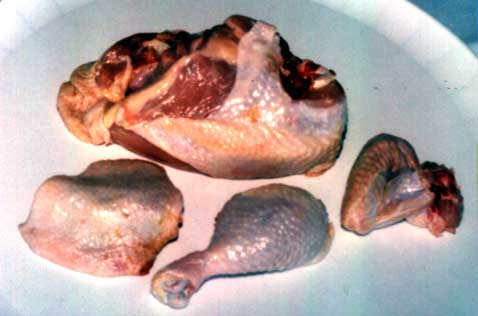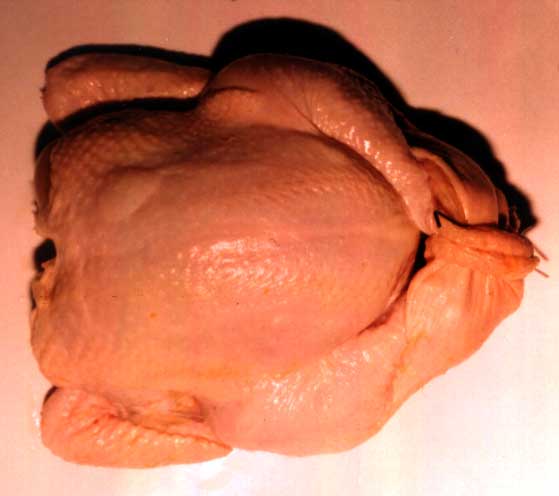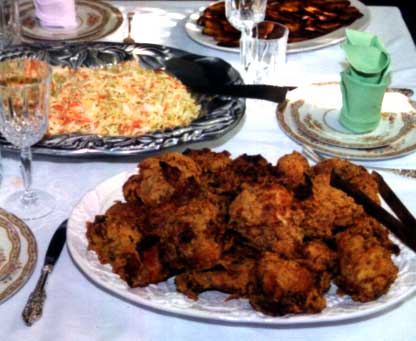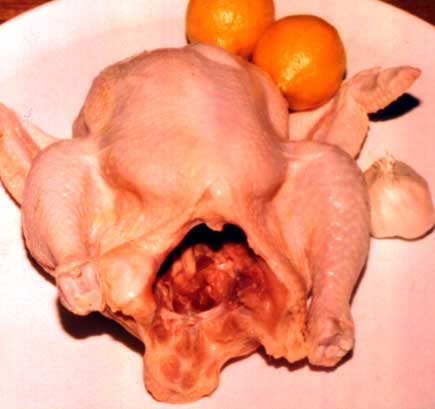What about Birds?
Before the advent of modern poultry growers, chicken were a vibrant member of the family life in many cultures. They produced eggs, which are good for breakfast and are necessary for many traditional baking affairs. Chicken is a popular dish among meat eaters at any age. It’s still relatively economical and adapts well to a wide variety of cuisine. Low in fat, easy to prepare and tasty to every culture.
Chicken can be
prepared whole or in parts, boned or de-boned, skinless or with skin. It may
be portioned as white or dark meat and by some measure each type lends to one
receipt or another.  Most supermarkets will provide these cuts and packaged
separately, subsequently the price is adjusted to match. If you are like me,
you will want to know how to prepare these parts and enjoy the low cost to
buying the whole bird. I still rather leaving the killing and plucking to the
pros.
Most supermarkets will provide these cuts and packaged
separately, subsequently the price is adjusted to match. If you are like me,
you will want to know how to prepare these parts and enjoy the low cost to
buying the whole bird. I still rather leaving the killing and plucking to the
pros.
There are many types of chicken available today, most popular are the free-range and corn fed, and these are full of flavor. Others are packaged with herbs and flavorings and some have butter or olive oil injected for self-basting. Chickens can weigh ¾ lb. to 6 lbs. or more. Cornish game hens are the smallest – ¾ to 2 lbs. broilers – 1 ¾ to 2 lbs. roasters – 3 to 6 lbs. fowl (boilers) 4 – 6 lbs. There are fryers, young and full bodied about 3 months old 2 to 3 lbs. and the corn fed, beautiful yellow color 2 ½ to 3 lbs.
Chicken Parts – Chickens are easy to section at home but most large supermarkets will have them prepackaged. When presented whole they usually have the giblets inside; quartered, the leg and thigh or ½ breast and wing; half, breast, thigh, drumstick or wings. All these may be boned, skinless or both. Ground chicken is also available but less frequent.
Choosing the Chicken
A chicken may be chosen based on what the recipes calls for and using the guide in our “What about Birds” section. For the exercise we are about to follow, lets choose “roasters” they come in a comfortable size and the meat is firm and lends itself to many recipes, may be stuffed or not and does not require extended cooking time.
Trussing a Bird
 Trussing is to hold
the bird together for a beautiful presentation, and holding the stuffing in
place for cooking. There are several ways to tie the bird together depending
on weather it’s stuffed or opened cavity. You may use strings skewers or be
creative by leaving slotted skins for tucking the legs, if you gutted the bird
yourself.
Trussing is to hold
the bird together for a beautiful presentation, and holding the stuffing in
place for cooking. There are several ways to tie the bird together depending
on weather it’s stuffed or opened cavity. You may use strings skewers or be
creative by leaving slotted skins for tucking the legs, if you gutted the bird
yourself.
- The un-stuffed bird; after cleaning, rub with seasoning all over and inside the cavity. Pull back the breast skin up and over the neck and secure against the back shoulders.
- Insert the legs into the lower cavity pressing against the breast and tuck under the skin across the parson’s nose. Alternately, you may hold both legs against the parson’s nose and tie securely with string.
- Fold the wing tips backwards and tuck behind the shoulders.
- For the stuffed bird: after filling the breast cavity fold the breast skin over and secure behind the back shoulder. After filling the lower cavity, tie the legs across the cavity to hold in stuffing. Use skewers or needle and string to lace skin across the opening.
Caution: Bring the stuffing to room temperature before filling cavity. Stuffing large birds require longer cooking time and the outer skin needs to be based to prevent over browning. Cook thoroughly; uncooked chicken does not destroy harmful bacteria.
Receipt – Baked chicken
My favorite is simply to clean the chicken whole, dry, season thoroughly inside and out then bake on a rack preferable about 15 minutes per pound in an oven preheated to 400 degrees.
1 - whole roasting chicken (about 3 ½ lbs.)
3 - tablespoons olive oil
¼ - teaspoon garlic powder
½ - teaspoon salt
¼ - teaspoon black pepper
¼ - teaspoon nutmeg
Mix all the ingredients together in a bowl, then bathe the chicken all over inside and out then bake.
After enjoying a wonderful hot meal with this roast, the left over chicken, separated from the bones and sliced or diced makes a wonderful additive to your favorite green salad receipt and will delight you and others.
Making it simple and economical
Remember the saying – two can live cheaper than one? Cooking two birds amount to the same. For the single person two birds can yield up to 10 separate filling meals, 5 for the couple and 2 or more for a family of four.
Imagine a Saturday
chore once per month could set aside meals for the family the entire month,
like money in the bank. Yes, packaged properly meats can freeze and stay well
for the month or more, can be safe and prepares well. Get those birds when
they are on sale, prepare them and store.
Preparing the Stock
For 2 chickens – broilers, about 3 to 4 lbs. Get out that 5 quart stock pot fill two thirds with water and set on a high fire, separate the back with your scissors, separate the wings, remove the neck bones, the gizzards and add to the pot. The livers set aside for your pate or snack; it gives a bitter taste to the brought. Blanch the chicken parts, then pour off the water removing any excess blood, then rinse them and start the process. Adding the chicken feet adds wonderful viscosity to your stock without reduction.
2-3 onions (no need to peel)
1 small fennel bud. Remove the leaves and chop
2-3 carrots chopped
4 sprigs of fresh thyme (about 1 teaspoon dried)
2-3 bay leaves
6 whole cloves or all spice
Put everything in the pot and bring to a boil, then lower to medium low heat and simmer for one to two hours skimming fraught as is necessary. A low simmer makes better flavor, keeps clarity and reduce evaporation. Keeping the pot half on the flame creates a natural convection current that pushes the impurities to one side of the pot and makes it easy for skimming away theses impurities. Keep liquid reduced to about quarts. Strain off liquid and place in refrigerator until jelled, skim off fat and this is your stock for soups, sauces or casseroles and may be used for basting.
These two chickens will yield a variety of meals, separating the parts and packaging them for single servings to freeze, makes it easy to retrieve for thawing and cooking.



